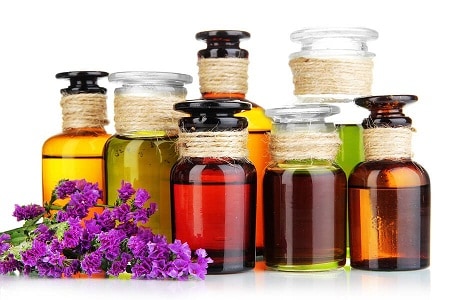by Andrew Pacholyk MS L.Ac
Peacefulmind.com
-much thanks to Banyan Organic Botanicals.
Ayurvedic oil has been relied upon for thousands of years as a fundamental part of Ayurveda. Oil is traditionally used in Ayurvedic healing in a variety of ways including raw consumption, cooking, massage, bathing, gargling, colon nourishment and nasal passage nourishment.
Two basic categories of Ayurvedic oil:
Base Oil, which is a pure, whole, organic oil from a natural source (such as sesame, almond, coconut, or sunflower)
Herbal Oil, which is a base oil infused with a decoction of one or more Ayurvedic herbs, combining the nourishing and soothing qualities of the oil with the healing properties of the herbs.
Ayurvedic oil is calming, soothing, moistening and lubricating. Furthermore, the word for oil in Sanskrit—sneha—is also a word for love, and therefore, holds a special place in the Ayurvedic tradition as the ultimate nourisher and carrier of love. Ayurvedic oil transmits these qualities deep into the tissues of the body.
Traditionally formulated herbal Ayurvedic oils are often created for dosha types:
Vata Massage Oil (supports space-air types) uses warming herbs that nourish and ground Vata. Supports vitality and vigor while it lubricates and supports a vata system. Promotes calmness and strength vitality.
This rejuvenating oil can be a synergistic blend of herbs, including ashwagandha, bala and passionflower. The herbs nourish and ground Vata, supporting vitality and vigor. Vata Massage Oil can be made from a base of organic sesame and olive oils. These oils warm and lubricate the delicate Vata system. Ayurveda highly recommends a daily self-massage to restore calm and provide strength.
Pitta Massage Oil (supports fire-water types) uses cooling herbs that calm and soothe Pitta. Relaxes the tension associated with pitta and softens the skin while providing a buffer from the irritations of daily life. It also promotes clear, healthy skin. This aromatic oil can be made with a cooling blend of herbs, including brahmi, guduchi and manjistha, in a base of sesame and sunflower oils. These herbs are traditionally used in Ayurveda to address Pitta by removing excess heat while relaxing the tension associated with Pitta. A daily self-massage benefits the skin, where Pitta tends to accumulate, supports healthy circulation and helps move toxins out of the system.
Kapha Massage Oil (supports water-earth types) uses invigorating herbs that warm and revitalize Kapha. Stimulates the body and sharpens the mind as it promotes energy and vitality. It renews the spirit and instills lightness of being. Formulate this in a base of organic sesame and sunflower oils. Use invigorating herbs including punarnava, chitrak, calamus, and rosemary. This energizing blend of herbs is activating and mobilizing, vital for balancing Kapha. Vigorous massage with warm herbalized oil reduces Kapha by promoting mild sweating, stimulating circulation and cleansing the system.
In Ayurveda, there are various recipes for Basti (Ayurvedic enema). You should consult a qualified Ayurvedic physician if you have any major medical problems. Nutritional basti can be used to assist with certain nutritional imbalances. Basti treatments should not be used with very old or frail individuals, although a 2 oz. sesame oil basti may be helpful if constipation is a significant issue.
Ayurvedic basti involves the administration of certain herbal preparations in sesame oil into the colon. Basti is the most powerful of the five main procedures of Panchakarma. These medicated enemas are used for various specific purposes. However, in general, Basti treatments are used to promote the elimination of the loosened vata dosha out through the rectum. These vata disorders may include constipation, distention of the colon, chronic fever, the common cold, sexual disorders, kidney stones, heart pain, vomiting, backache, neck pain and hyperacidity.
Enemas should not be given to persons suffering from shortness of breath, chronic abdominal pain, bleeding from rectum, cough, diarrhea, or severe anemia.
Basti Enema Oil:
Good for everyone. (Tridoshic) Basti
• 4 oz warm sesame oil
• 4 oz organic raw honey
• 4 oz warm purified water
• Mix them very well, administer as enema, and retain about 15 minutes or longer if possible. Mixture should be warm when using. This enema does not have contraindications.
Nasya Oil Recipe
An effective Ayurvedic remedy for nasal cleansing is nasya. Nasya is one of the five purification methods in Panchakarma therapy and is also commonly done as an Ayurvedic treatment.
Use a small glass bottle or jar, about 5-10 mL
Fill bottle about 2/3 full of unroasted sesame oil (don’t use a cooking oil, get one sold for body)
10 drops eucalyptus oil
8 drops peppermint oil
Top up bottle with sesame oil, close, and shake to combine oils.
Nasya helps to lubricate the nasal passages and clean out excess mucus from the sinuses. Warning: Do not use if you are pregnant or have a cold, flu or sinus infection. The nose is considered the direct route to the brain and also the doorway to consciousness. Therefore the administration of Nasya improves intelligence and memory. It is the entrance for prana, the vital life force, which comes into the body through the breath. Healthy uncongested breathing is important to ensure proper flow of prana throughout the head and body. When an excess of bodily fluids accumulates in the sinus, throat, nose, or head areas, it is best eliminated through the nose. Balancing for Vata, Pitta and Kapha, Nasya Oil is also traditionally said to improve quality of voice, strengthen vision, and promote mental clarity.
Try this:
Comfortably lie down on your back and tilting your head back. Use a pillow under the neck only and tilt the head down (backwards – looking up on the ceiling).
Place 3-5 drops of either Dosha specific Nasya oil in each nostril. Apply or administer drop by drop in order to absorb the oil through the nostril better. Massage in circular motion the outside perimeter of the nostril to ensure drops go down the nasal passage.
Breath in gently and then rest for two minutes allowing the oil to penetrate.
Learn more about the wonders of Ayurveda…




